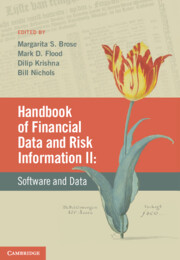Book contents
- Frontmatter
- Contents
- List of contributors
- Preface
- VOLUME II: SOFTWARE AND DATA
- PART IV DATA OPERATIONS IN FINANCIAL INSTITUTIONS
- PART V DATA MANAGEMENT TECHNOLOGIES
- PART VI IMPLEMENTATION OF DATA AND ANALYTICS PROGRAMS
- 25 Project implementation
- 26 Operations management
- 27 Data governance and data stewardship
- Index – Volume II
- References
26 - Operations management
from PART VI - IMPLEMENTATION OF DATA AND ANALYTICS PROGRAMS
- Frontmatter
- Contents
- List of contributors
- Preface
- VOLUME II: SOFTWARE AND DATA
- PART IV DATA OPERATIONS IN FINANCIAL INSTITUTIONS
- PART V DATA MANAGEMENT TECHNOLOGIES
- PART VI IMPLEMENTATION OF DATA AND ANALYTICS PROGRAMS
- 25 Project implementation
- 26 Operations management
- 27 Data governance and data stewardship
- Index – Volume II
- References
Summary
Introduction
Success or failure of a financial and risk analytics ecosystem not only depends on the derived business value of that system, but also relies heavily on how the financial and risk analytics ecosystem and data stores are managed behind the scenes. Support, stability and overall performance of the complete financial and risk analytics environment are key factors to success. A financial and risk analytics ecosystem, henceforth abbreviated to FRA ecosystem, includes the complete set of tools and technologies needed for financial analysis. This includes analysis tools on the desktop and in intermediate servers, as well as all the underlying data stores, data-marts and data-warehouses. Support of this FRA ecosystem is typically called operations management. The following sections will discuss in detail the best practices of operations management for an FRA ecosystem.
The FRA ecosystem
The FRA ecosystem comprises many different components, including source systems and business intelligence (BI) tools. In Figure 26.1, you will see “source systems” on the left. These are the Operational systems that run the business and are inputs to the FRA ecosystem. Operational systems are often called transaction systems because they process the transactions of the business. Examples of Operational or Transaction systems are Credit Card processing, General Ledger systems, and Accounts Payable systems.
Also in Figure 26.1, you will see on the right side of the diagram both “Desktop” and “BI Tools.”
- Type
- Chapter
- Information
- Handbook of Financial Data and Risk Information IISoftware and Data, pp. 433 - 463Publisher: Cambridge University PressPrint publication year: 2014



